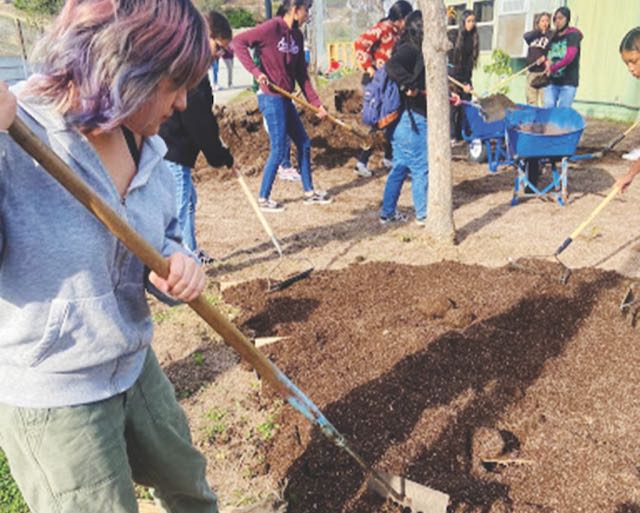
SANTA CRUZ COUNTY—Since it began in January, Santa Cruz County’s composting program has diverted nearly 50,000 tons of food scraps from the Buena Vista Landfill, vastly reducing the amount of methane being released into the atmosphere and reshaping the way residents view their trash.
That number–an annual estimate–is a significant reduction from previous years, since roughly 44% of the material previously being tossed into the landfill has historically been food, says Santa Cruz County Recycling & Solid Waste Services Manager Kasey Kolassa.
Better still, the food waste is being converted into rich compost that can be used by farmers and gardeners to augment soil.
“It’s great,” Kolassa says. “It’s being diverted from the landfill, it’s making a product that helps to grow crops. It helps save water, it provides nutrients. It’s a system that doesn’t need a landfill anymore.”
In late November, 30 cubic yards of that compost found its way to Pajaro Valley High School, where it will be used for gardening projects, says Watsonville Senior Environmental Projects Analyst Tami Stolzenthaler.
“That was really exciting,” she says. “It’s demonstrating how people’s food waste and plant waste is turned into this really high-quality compost that our schools and our farms and our community really needs.”
The program is mandated under Senate Bill 1383, a law that requires every jurisdiction in the state to divert their food waste from their landfills and into an organics recycling program. The law also calls for an enforcement arm of the new law to ensure residents are doing their part.
Authored in 2016 by then-Senator Ricardo Lara, the law was created to reduce atmosphere-harming gasses such as methane, hydrofluorocarbon and anthropogenic black carbon. It took effect on Jan. 1.
The law comes as County officials are fretting about the impending closure of Buena Vista Landfill within roughly eight years, and are therefore seeking an overall reduction in waste.
The County for the past 20 years was already collecting yard waste from residents in green bins provided by the GreenWaste company, and turning that into mulch at the Buena Vista site.
In 2008, the County began collecting food scraps from a handful of restaurants and businesses for a small-scale composting operation at the landfill.
But the new law kicked those efforts into high gear. The larger amount of food waste coming from nearly every residence in the County–which also goes into the green containers–requires it to be hauled to Monterey Regional Waste Management District, where it is processed. From there, Salinas-based Keith Day Company sells the compost to commercial agriculture and retail landscape businesses, Kolassa says.
While most cities and the entirety of the County’s unincorporated region is participating in that program, the City of Santa Cruz—with its own landfill and recycling center—has taken a different approach.
Food waste there is taken to the City’s resource recovery facility at 605 Dimeo Lane, where it is screened for contaminants and then processed in Santa Clara into feedstock such as pellets for pig feed, in addition to biodiesel and fertilizer, says Waste Reduction Manager Leslie O’Malley, who says the program keeps 40 tons per week from the landfill.
“When you think about it in those terms, it’s really incredible,” she says.
Kolassa says residents have largely cooperated with the program, with some finding the mess and smell distasteful.
But he hopes that ongoing outreach programs will bring more on board, as SB 1383 calls for eventual enforcement, with County officials performing random inspections of GreenWaste and trash bins. Penalties could be as high as $100 for first-time offenders found to be putting food in their trash cans.
“Our approach has always been more outreach,” he said. “But now we have the ability if need be to issue fines—to correct their behavior,” he says.
Another challenge is convincing people not to place plastic bags of any kind in with their food waste, even those deemed compostable, since they don’t fully break down during the composting process, making the final product undesirable for farmers, Stolzenthaler says.
“It really starts with the people at home who are making the effort to separate their food and plant waste,” she said. “People’s garbage is becoming this high quality compost that our farms and schools and gardens really need and want.”
Like Kolassa, O’Malley says she expects the amount of food diverted from the landfills to increase as growing numbers of people are willing to separate their food from their trash.
But at the same time, she also hopes to see a commensurate drop in the amount of food they throw away.
“In my perfect world we would have really high participation and really low numbers, because that would mean that people have prioritized the even more important effort of reducing food waste as opposed to seeing this third-party collection as a cure-all,” she said.












“… some finding the mess and smell distasteful” Kasey Kolasssa
How many residents in Watsonville are paying $35 a month for a green food waste can? Anyone know how much the City of Watsonville is paying to collect food waste weekly and deliver it 20 miles south to Monterey? By whom in Watsonville and for what purpose has any of the resulting compost been purchased?
It seems that a home garbage disposal unit might address the “methane issue” in a good number of cases. As well as reduce the truck emissions caused by the collection and transportation of food wastes.
Or another way you could help save the planet, is to raise a few porkers in your backyard and re-purpose your food waste into ham sandwiches.
Earl
The stink and rat problem has doubled in my neighborhood. Also the trucks routinely leak this sticky goo onto the streets. The bugs and rats will take over our town. Governor do you have any other bright ideas?
I am going to have to pass on rodent prevention measures to my tenants
Pickles, we already have home garbage disposal units in most homes and apts. in Watsonville. this program is helping reduce methane gas in its negative effect on global climate change. Pickles, you need to read up about how methane gas is produced and how to reduce it , either in our public library or online in the internet.
1) Don’t use your garbage disposer as a garbage can.
It just clogs (expensively) your drain lines as well as adding more issues if it actually reaches the sewage disposal plants. Where ever the organic material breaks down, it releases gases into the environment.
2) Composting is great, but does nothing to reduce “global warming”. Organic compounds-plant/animal decomposition, release gases no matter where it happens. Worldwide, 93% of released carbon dioxide is produced naturally during the breakdown of mostly plant matter, as it decomposes in the environment. All mankind produces less than 7% of greenhouse gases.
3) Get a couple of chickens! They’ll eat nearly all your food waste and give you eggs the next morning!!!
Get a quality, efficient garbage disposal like an Insinkerator and send your wastewater on to the Watsonville Treatment Facility.
They protect public health and the environment, and serve as the first line of defense in protecting the Monterey Bay’s precious water quality. The facility treats wastewater for tens of thousands of residents, as well as commercial and industrial businesses. Over 120 miles of sanitary sewer pipeline and 13 lift stations are used to transport wastewater to the facility for treatment that can process up to 12 million gallons of wastewater every day during dry weather, and 36 million gallons during wet weather.
The wastewater is treated to the advanced secondary treatment level for ocean discharge and advanced tertiary treatment for food crop irrigation. Both levels of treatment undergo extensive monitoring and testing to insure compliance with all Local, State and Federal pollution prevention laws prior to being discharged to the Monterey Bay over a mile off shore, or for agricultural reuse.
Biosolids, the organic residual of wastewater treatment processes, are applied to farmland used to grow hay crops for livestock. Biosolids are produced by an anaerobic digestion process which also produces methane (biogas). An energy recovery facility uses the methane in a generator to produce electricity and hot water. At times the energy recovery facility generates more energy than is needed for the entire wastewater plant and exports electricity to the power grid.
Hi Earl
I worked on the mutil million $$ sewer plant upgrade in Watsonville a few years back…
Most people have no idea what it takes to flush a toilet!
As a property manager/maintenance person, I can’t tell you how many times I’ve had to snake out lines because people use the disposal as a garbage can..
Still like my chickens!!!
Bigger problems are the things people flush. Most home disposal are too small and underpowered (and noisy).
https://insinkerator.emerson.com/en-us/insinkerator-products/garbage-disposals
It says on the county website that they accept 450 tons of trash PER DAY at the 2 main landfills in the county. So after almost a year of this, they’ve saved one ninth of one day’s worth of trash. That is nothing and how much diesel or gas did they burn driving extra dump trucks around for an entire year? Sounds like a massive FAILURE to me and I’m guessing it added much more pollution. People see “50 tons!” and think that’s alot. It’s actually nothing.
“. . . how much diesel or gas did they burn driving extra dump trucks around for an entire year?”
Plus wages and equipment maintenance.